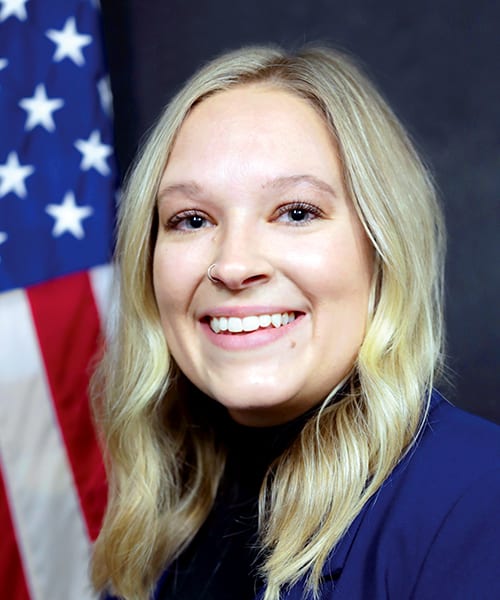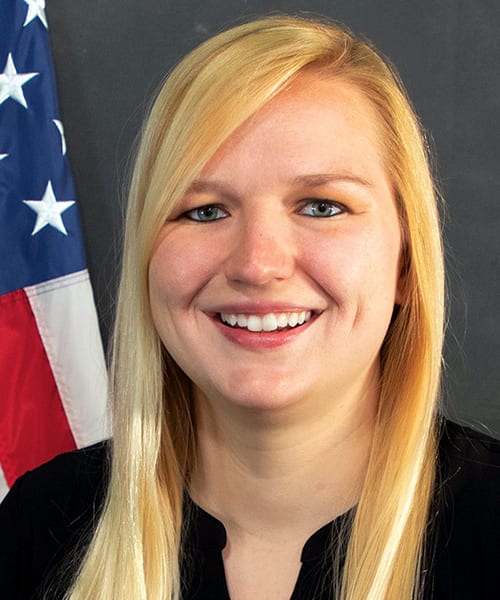

bulletin | feature
Women in the Department of Defense:
Recognizing contributions to our nation
By Randi Swanson
Since the birth of the United States, women have served the country in a multitude of roles.
Traditionally, women supported the nation during wartime through caretaking positions. But women also went out of their way to be more actively involved in combat responsibilities, such as by disguising themselves as men to march to the front lines of battle.1
Thanks to changing social norms and new legislation, women today can serve in the armed forces without hiding their identity. As of 2021, women make up about one in five active-duty military personnel and about one in three civilian military personnel.2,3 Getting to this point, though, has been a bumpy and twisted road.
In 1948, almost three decades after gaining the right to vote, women in the U.S. finally gained the right to serve as permanent members of the armed forces through the Women’s Armed Services Integration Act. However, inequalities were written into the law, such as restricting women from serving in combat positions, limiting the number of women who could be officers, and legally establishing that a woman could not command a man.
Besides legal restrictions, women also experienced limited career opportunities in the defense sector due to external economic and societal reasons. For example, women often assume primary care responsibility for children,4 and they may face sexism in what are supposed to be professional environments.5
Despite these barriers, women still pushed to achieve equality. During the Vietnam War, women fought for the right to serve in higher ranking positions, the ability to command units that included men, and to remain in the military while pregnant. Around the turn of the 20th century, women broke through on several fronts, including becoming a fighter pilot and four-star general.6
Though today’s women have greater autonomy to serve the U.S. in roles of their choosing, they still face persistent and nuanced challenges. For example, people are less likely to pursue certain careers when they do not see others like themselves in that field.7 This lack of role models can be due to both limited diversity within the sector and not recognizing the contributions of diverse individuals.
The U.S. Department of Defense (DOD) is aware of this underrepresentation and is continually updating its policies to foster a welcoming and equitable environment. For example, in 2022, Congress enacted the FY 2022 National Defense Authorization Act, which guarantees 12 weeks of paid parental leave for service members who bring a child into their family through birth, adoption, or long-term foster care placement.
Professional organizations can also provide the encouragement and support necessary to pursue a career in defense. For example, the ACerS President’s Council of Student Advisors (PCSA) has supported the development of many young researchers who have since gone on to work in different institutions and laboratories overseen by the DOD.
The following pages profile seven women who were previously members of the PCSA and now work for the DOD as civilian military personnel. We thank them and all women for their service.
About the author
Randi Swanson is a third-year Ph.D. candidate at the University of California, Davis and Pathways intern at the Air Force Research Laboratory. Contact Swanson.
ADVERTISEMENT
ACerS President’s Council of Student Advisors
ACerS President’s Council of Student Advisors (PCSA) is the student-led committee of ACerS. Its mission is to engage students as active and long-term leaders in the ceramics community and to increase participation in ACerS at the local, national, and international levels. The 2024–25 class of PCSA delegates consists of 53 students from 28 universities, representing 10 countries. The seven women profiled on these pages were previously members of the PCSA and now work for the DOD as civilian military personnel.
Air Force
Lisa M. Rueschhoff
Doctorate in materials engineering, Purdue University
I am a senior materials research engineer in the Materials and Manufacturing Directorate (RX) at the Air Force Research Laboratory (AFRL) in Ohio. My research focus includes additive manufacturing and advanced processing methods for ultrahigh-temperature structural ceramics and composites as well as materials and structures development for morphing aerospace concepts.
I joined the PCSA in 2014 during graduate school at Purdue University, first serving as the Communications Committee chair and then as the 2015–2016 Council chair. My time spent on the PCSA was instrumental in my career to develop important team management and networking skills. Connections I made with fellow PCSA members persist to present-day friendships and collaborations across the world.
I was drawn to working for the DOD due to the connection I felt to the mission and the emphasis made at AFRL/RX to creating a supportive and inclusive workspace. I have been active in the diversity, equity, inclusion, and accessibility initiatives and am a member of resource groups for working moms and dads and women in RX.

Ashley M. Hilmas
Doctorate in materials science and engineering, University of Michigan
I am a materials research engineer in the Materials and Manufacturing Directorate (RX) at the Air Force Research Laboratory (AFRL) in Ohio. My background involves understanding damage evolution in ceramic matrix composites via in situ X-ray computed tomography. At AFRL, I have continued this research and study combined environmental–mechanical effects on structural ceramics for high-temperature applications.
I have been involved with The American Ceramic Society since 2011 when I joined the student organization Material Advantage at Missouri University of Science and Technology (Missouri S&T). While at Missouri S&T, I served as secretary and president of the Missouri S&T Material Advantage Chapter. It was during this time I first engaged in student outreach and volunteering for student summer camps. While in graduate school at the University of Michigan, I continued with my participation in ACerS by joining the PCSA, where I served initially as Finance Committee chair and eventually as the 2017–2018 Council chair.
Throughout my time in the PCSA, I established collaborations and friendships that are thriving to this day. The PCSA allowed me to grow as a leader and launched my enthusiasm for mentorship. I make it a priority to continuously learn and grow as a mentor, and I am passionate about using my role at the DOD to provide opportunities for students across various engineering disciplines.

Katie N. Detwiler
Doctorate in materials science and engineering, University of Virginia
I work as a materials research engineer in the Materials and Manufacturing Directorate at the Air Force Research Laboratory (AFRL) in Ohio. My research focus includes ceramic matrix composites and other high-temperature materials for structural and propulsion applications. I have specialized in evaluating materials in representative environments, analyzing damage modes such as applied mechanical and thermal loads, oxidation, and combined effects.
I joined ACerS as an undergraduate student at Wright State University while interning at AFRL. I continued my membership and joined the PCSA during my Ph.D. studies at the University of Virginia. Serving on the PCSA Outreach Committee allowed me to meet other graduate students and members of the community, which I was especially thankful for as it was during the COVID–19 pandemic.
The friendships and connections that I made through the PCSA have benefited collaborations in my career today at the DOD. I am honored to be a part of the DOD family, working toward a shared mission to support the warfighter.

Army
Victoria L. Blair
Doctorate in ceramics, Alfred University
I am a materials research engineer at the Combat Capabilities Development Command Army Research Laboratory, part of the U.S. Army Futures Command. My research focus is ceramic synthesis and processing, specifically for infrared-transparent ceramics, which could be used as laser gain materials, optical lenses, or windows.
PCSA played a critical role in preparing me for my career by providing me opportunities to develop skills in leadership, program management, and public speaking, including presenting to diverse audiences about deeply technical content. The network I developed through the PCSA brought me to the Army Research Laboratory, and I continue to collaborate closely with other PCSA alumni who now work across the DOD.
When Congress passed the 2022 National Defense Authorization Act, it included a policy that provides 12 weeks of paid leave to service members and civilians who welcome a child into their homes. Since the policy is not gendered or based around the health of the birthing parent, my male colleagues have supported their spouses by taking advantage of the full 12 weeks of leave as well, often spread throughout the year. This equitable approach reduces the overall stigma of taking time off from work for childrearing and is having a positive effect on our workplace culture.

Aubrey L. Fry
Doctorate in materials science and engineering, The Pennsylvania State University
I am a materials research engineer at the Combat Capabilities Development Command Army Research Laboratory. My research spans a variety of ceramic and transparent materials, developing chemistries, fabrication, and post-processing techniques to refine and augment mechanical and optical properties.
My time in the PCSA was rewarding personally and professionally, growing friendships and an invaluable ceramics and glass research network. I particularly enjoyed volunteering for STEM outreach events with the Ceramic and Glass Industry Foundation and being the student delegate to the Glass & Optical Material Division’s executive board, which gave me a view into how ACerS functions and flourishes.
Mission mindset is fundamental to my work as a civilian scientist in the DOD Department of the Army, and part of that mission is STEM outreach, which is inexorably linked to diversity. Organizational understanding and mission orientation are critical elements of any team, but teams must also embody diversity, which enables timely and productive scientific invention. The diversity of students and minds that the PCSA brings together and cultivates is a shining example to all organizations.

Navy
Olivia Brandt
Doctorate in materials engineering, Purdue University
I am a materials engineer in the Spacecraft Engineering Division at the Naval Research Laboratory in Washington, D.C. My research focuses on maturing technologies for near-net-shaped fabrication of ceramic matrix composites for space-related applications.
During my years in the PCSA, I served on the Communications and Conference Programming and Competition Committees, was the 2021–2022 PCSA chair, and volunteered with the Ceramic and Glass Industry Foundation at outreach events. The variety of roles and experiences I had in the PCSA provided me with leadership and networking skills along with friends and mentors, which better prepared me to transition into the workforce.
One aspect of working in the DOD I enjoy is the range of technology readiness levels being researched. We can do everything from basic research focusing on novel ideas to flight test ready components and all levels in between.

Lavina Backman
Doctorate in materials science and engineering, University of Virginia
I am the lead materials engineer in the Spacecraft Engineering Division at the Naval Research Laboratory in Washington, D.C. My research focuses on materials for extreme environments, including ultrahigh-temperature ceramics and composites.
While in the PCSA, I served as the Outreach Committee chair in my first year, after which I served on the Communications Committee as well as the Basic Science Division liaison. I credit the PCSA for preparing me as both a scientist and leader. While in the PCSA, I met researchers who eventually became collaborators and lifelong friends. I also learned the value of service and community in the scientific endeavor, a lesson I carry to this day.
I am passionate about pushing the boundaries for what materials can do in extreme environments. The Naval Research Laboratory, being a mission-driven organization that also values scientific innovation and discovery, provides both a purpose and an excellent venue for the exploration of this passion.


